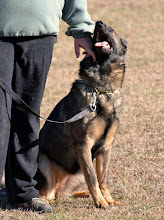As supposition, I would say that a dog with extreme angulation is more likely to have ACL injuries and back issues--but they are no more or less likely to have HD. I do think most of these lines are more likely to have Degenerative Myelopathy (because it is a genetically inherited issue, and it is often found in the tightly bred, often inbred American show lines) (inbreeding is a factor because it concentrates the genes, thus making the incidence of the genes for DM or other problems higher and sometimes all but impossible to avoid if you stay in that gene pool)--but you also find DM in German show and working lines, although it is more uncommon (you also find back injuries in working lines and until recently the testing to figure out the difference was often prohibitively expensive).
We could also get into the discussion of hereditary illness versus a hereditary propensity to injury--that, is dogs aren't born with ACL or knee injuries, but a dog's genetic knee construction can make a knee ligament injury extremely likely--and this isn't specifically a GSD concern. For example, almost all GSDs (all bloodlines, apparently) have a narrower space in the spinal column for the spinal cord than is common in most other breeds. This in itself may not cause any issues (although it can), but if there is an injury around the spinal cord, there is less room and the injury is more likely to cause problems. So to speak, there is less room for error.
But going back to angulation and "low hips" -- so, the big issue is that the function of a dog with extreme angulation becomes curtailed--lack of stability in movement at any pace other than a trot, lack of agility, turning ability, tight turns, etc. This lack of stability leads to a lack of usefulness--imagine one of these dogs as a service dog, guiding a blind person, chasing down someone in a police chase, or even doing a bomb search or drug search or doing cadaver or live find SAR work.
In contrast, a well-put-together dog, well balanced and athletic, is more likely to have full use of every muscle and have a natural physical confidence. For example, Hunter knows at all times where every foot is planted. She boings like a spring at the gate of her kennel, doing vertical leaps that bring her head over the top of the 6 foot gate panel. She (and her mother Nike) could do a 540% turn on a 12-inch dog walk board that is 5 feet above the ground and not blink twice. One training tool is to put a ladder on the ground and ask your dog to walk through it, thus learning to think about where its rear feet are hitting the ground--Hunter trotted through and asked me what was for dessert. :)
There are a lot of articles out there on this topic--some better than others. I like Linda Shaw's analyses:
For example, here is an excellent illustrated article on movement in dogs with a focus on the GSD.
Breeders must be careful, however, not to develop the flying trot into a caricature of itself, producing animals that are loosely ligamented and over-angulated in the rear, and that show a length of stride that, while impressive to the uninformed, is excessive (Fig 22). This extreme type loses its athleticism at other gaits and in jumping. The correct GSD is capable of a supported trot that is longer, more flowing and more efficient than any other breed, but it can also display the most efficient and spectacular version of the flying trot (Fig 23).
Also check out this informative page on the different types of GSD.








